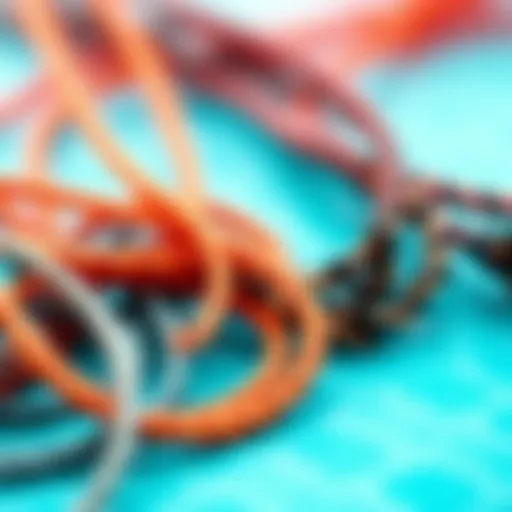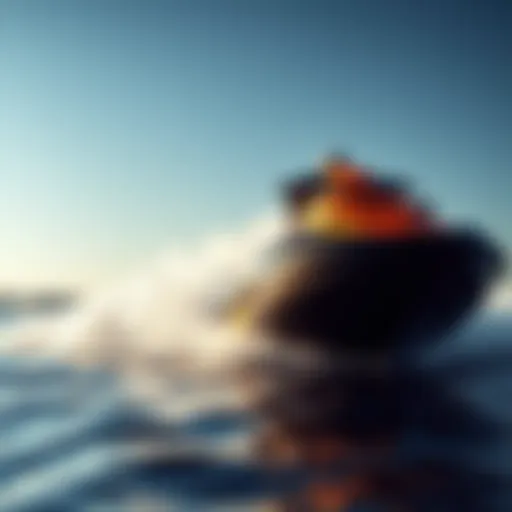Understanding the Land Surfboard: A Comprehensive Guide
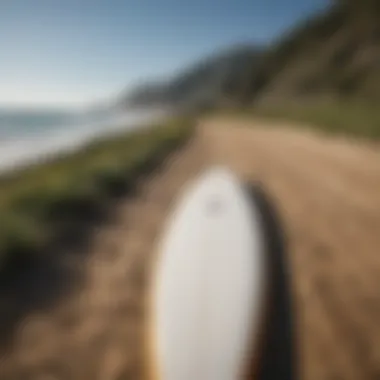

Intro
In the realm of outdoor sports, innovation often leads to exciting new ways to engage with nature. One such exciting development is the land surfboard. As the name suggests, this device brings the exhilaration of surfing to solid ground, allowing enthusiasts to carve their way through parks, trails, and other open spaces. It serves as a bridge, connecting traditional water sports to a more versatile, land-based experience. Whether you’re an old hand at surfing or just beginning to dip your toes into the world of outdoor activities, understanding the mechanics and nuances of the land surfboard can significantly enhance your experience.
This guide will unravel the features that set land surfboards apart, exploring their functionality and the benefits they offer. We’ll delve into essential techniques for effective use, essential gear choices, and the growing community that embraces this exhilarating alternative to traditional surfing. Keeping safety in mind, we’ll also provide insights on how to avoid common pitfalls that may arise during your outdoor excursions.
With the increasing popularity of this unique sport, it's the right time to grasp how land surfboards can elevate your skills and foster connections within communities, making outdoor activities not just a hobby but a lifestyle.
Prelims to Land Surfing
Land surfing, a term that might conjure images of gliding over sandy beaches or rolling hills, actually represents a rich tapestry of outdoor adventure that blends the thrill of surfing with the versatility of land-based sports. It’s often overlooked, yet its importance is becoming increasingly recognized among outdoor enthusiasts, particularly those who seek alternatives to traditional water sports. This section will explore what land surfing means, its significance in sports culture, and the benefits it offers.
Defining Land Surfboarding
Land surfboarding, sometimes referred to as land paddle boarding, involves riding a specialized board that goes beyond standard skateboarding. The key here lies in the board's design which is tailored for handling diverse terrains – be it asphalt, dirt trails, or grass.
To put it simply, land surfboarding lets you take the surfing experience off the waves and onto solid ground. This sport has its roots in traditional surfing culture, but it embraces a wider variety of environments, making it accessible to a broader audience. At its core, it captures the essence of surfing—balance, flow, and freedom—while introducing elements unique to land travel.
History and Evolution
The origins of land surfboarding can be traced back to the late 20th century, emerging from the need for surfing enthusiasts to practice their skills when the surf was flat. Initially, crude versions of land surfboards began appearing, resembling oversized skateboards. They were often a hodgepodge of surplus parts, reflecting a DIY spirit common among early adopters.
Over time, styles and technology evolved, paving the way for modern land surfboards. Different brands started designing models that catered to specific terrains and skills, enhancing the performance and safety of the boards. Today, the range of designs includes all-terrain boards suited for rugged trails alongside sleek models for smooth pavement.
The growth of this sport resulted not only in advanced design but also in a burgeoning community of sporters who share tips, tricks, and locations.
"Land surfboarding does not just rely on the beach; it opens up entire landscapes for thrilling experiences."
The ongoing popularity of social media platforms like Instagram and Facebook has played a significant role in connecting like-minded individuals, fostering community efforts and events that celebrate this niche but blooming sport.
Thus, what began as an avenue for surf practice has evolved into a celebrated outdoor activity, complete with competitions, events, and increasing participation from diverse groups. Understanding land surfboarding's history allows enthusiasts to appreciate its journey and the vibrant community it fosters.
The Mechanics of a Land Surfboard
Understanding the mechanics behind a land surfboard is crucial for anyone looking to either deepen their knowledge or embrace this thrilling activity. The components, design variations, and overall mechanics work hand in hand to enhance the surfing experience. By diving into these elements, enthusiasts can make informed decisions about both their riding style and board choice.
Components of the Board
Deck
The deck serves as the main platform for land surfing, shaping not just the rider's experience but also their performance. A strong yet lightweight deck is paramount, as it provides stability while ensuring maneuverability. Popular choices often include materials like plywood or composite materials, each offering unique characteristics.
One significant characteristic of a well-designed deck is its concave shape, which aids in foot grip. This design provides an added layer of control when navigating bends or executing tricks. However, choosing a deck with an exaggerated concave may limit some riders, especially those who prefer a more flat approach that provides ample space for foot placement.
Wheels
The wheels of a land surfboard determine how it interacts with various terrains. Typically made of durable polyurethane, these wheels come in varying sizes and hardness levels. Larger wheels offer ease on uneven surfaces, which is particularly beneficial for all-terrain boards. On the other hand, smaller wheels may appeal to riders who frequent smoother pavements.
An interesting aspect of wheels is their durometer rating, which measures hardness. A softer wheel might grip better on rough terrain but can wear down faster, while a harder wheel survives longer but can sacrifice some traction. The challenge for riders is finding that sweet spot based on the terrain they typically encounter.
Trucks
Trucks are the crucial pivot point, linking the wheels and deck, and they play a major role in the turning capability of the board. Made of metal predominantly, the quality of the truck can affect a rider’s stability and speed. A high-quality truck typically features precision in its design, allowing for smooth turns without losing balance.
Riders often favor adjustable trucks because these allow for personalized responsiveness; a tighter setting provides stability at high speeds while a looser setting aids in easier, sharper turns. One downside is that adjusting the trucks can require trial and error, impacting ride quality before the right balance is struck.
Design Variations
All-Terrain vs. Street Boards
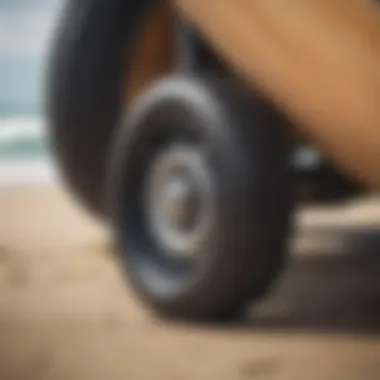

When examining design variations, all-terrain boards and street boards cater to distinct riding experiences and environments. An all-terrain board is built robustly to handle rough and diverse surfaces – think of gravel trails and park sidewalks.
Street boards, conversely, are generally lighter and designed for urban paths, with a focus on agility. The trade-off here often involves durability versus agility; while an all-terrain board boasts strength, a street board offers swiftness in urban settings.
Material Considerations
Lastly, the materials employed in constructing a land surfboard are critical to its performance. Wood and composite materials offer varying levels of flexibility and rigidity, both playing pivotal roles in how the board feels in action. A wooden board can absorb shock more effectively, translating to a smoother ride over bumps, while a composite board may respond faster to rider movements.
Choosing material can greatly influence rider experience but also comes down to personal preference and intended use. Heavyboard riders might prefer more durable materials, while lighter materials might suit those who prioritize speed and control.
"The mechanics of a land surfboard, often overlooked, can define the surfing experience, elevating it from mundane to exhilarating."
In summary, the mechanics behind a land surfboard are the foundation for developing skills in this sport. Understanding each component and how they complement one another helps enthusiasts choose wisely, ultimately enhancing their enjoyment.
Skills and Techniques
When diving into the art of land surfboarding, mastering the skills and techniques is as crucial as having the right gear. Just like trying to read a map without knowing where north is can send you round in circles, not honing your riding skills could lead to some less-than-favorable experiences on your board. Understandably so, riders come from different backgrounds, and each posseses unique strengths and weaknesses that influence their approach. Therefore, discussing the intricacies involved here is not just beneficial; it's vital.
Basic Riding Techniques
Starting with the basics is what makes the journey enjoyable for newcomers. Before attempting exhilarating tricks, one should ensure they can ride confidently and maintain their balance. Here are a few essential techniques to kick off:
- Stance: The primary aspect of riding a land surfboard is your stance. You can position your feet either in a regular or goofy stance. Regular means left foot forward while goofy means, well, right foot forward. Testing both positions can help riders figure out what feels more natural.
- Pushing Off: Place one foot on the board and push off with the other, similar to how you'd ride a skateboard. Keep your knees slightly bent to absorb shocks and maintain better balance.
- Turning: To initiate a turn, lean into the direction you want to go. Your body weight acts like a pendulum, allowing for smooth twists and curves.
Learning these basic techniques establishes a solid foundation, reducing the learning curve significantly. It should be noted that practice makes perfect; the more time spent riding, the more instinctual these maneuvers become.
Advanced Maneuvers and Tricks
Once the basics are second nature, leveling up to more advanced maneuvers and tricks opens up a whole new world of riding possibilities. However, these require not just skill but also courage.
- Carving: This involves deeper leaning into turns, resembling a surfer's motion on water waves. By applying pressure to the edges of your board, you can create fluid-like movements.
- Ollies: A fundamental trick for any rider, an ollie involves popping the tail of the board on the ground while leveling the front in the air. It’s essential for jumping over obstacles and adds flair to your riding style.
- Slides: For more experienced riders, sliding allows for controlled drifting around turns. This requires good grip with the wheels paired with excellent balance to keep from toppling over.
The importance of safety cannot be overstated with these advanced tricks—wearing protective gear is not optional but a necessity as risks naturally increase with competence.
Balancing and Steering
Mastering the art of balancing and steering can spell the difference between an exhilarating ride and an embarrassing tumble. Here are some key takeaways:
- Body Positioning: Your center of gravity plays a pivotal role. Keep your shoulders aligned with your feet; a misalignment can lead to a fall.
- Knee Flexion: Bending your knees, much like in skiing, means more stability. The more you engage your legs, the better your absorption of bumps on the terrain.
- Cognitive Awareness: It is essential to visualize your path ahead. Anticipating obstacles or turns can help you steer more effectively.
"Riding is not just about the motion; it’s about feeling the ground beneath you and how you interact with it."
Engaging with one’s surroundings creates a symbiotic relationship between rider and board. As seasoned land surfers would attest, developing one’s skills on the board translates to newfound confidence and a deeper appreciation for both the activity and its community.
Safety Considerations
When engaging in any outdoor sport, safety remains paramount. In the realm of land surfing, where speed and maneuverability play key roles, implementing a safety-first approach can significantly reduce risks associated with injuries. Understanding the importance of protective gear and being aware of terrain hazards sets the foundation for an enjoyable and secure riding experience.
Protective Gear Essentials
Helmets
One cannot overstate the importance of helmets in land surfing. This piece of equipment is akin to a knight’s helmet, guarding against unforeseen mishaps. A high-quality helmet, designed specifically for action sports, offers superior protection. Most helmets today boast an impact-resistant outer shell and a cushioned interior. The unique characteristic is the fit: an adjustable chin strap and inner padding ensure that it stays snug while you ride. This snug fit not only keeps the helmet in place but also minimizes the risk of injury during sudden falls.
The aerodynamic design of helmets helps in ventilation, vital during summertime rides. Despite this, it's essential to note that not all helmets provide the same level of protection. Some may be lightweight and breathable but might compromise on sturdiness. Overall, a helmet is an indispensable safety gear, crucial for anyone venturing onto land with a surfboard.
Knee and Elbow Pads
Just like helmets, knee and elbow pads form a crucial part of the protective gear equation. These pads protect the joints, which are highly susceptible to injury during falls or while performing tricks. A distinctive aspect of these pads is their shock-absorbent padding, often made from advanced foam material that hugs the joints without hampering movement. This allows for flexibility while taking the brunt of the impacts.
These pads are not just a safety measure; they also offer confidence to riders, empowering them to push their limits, knowing they are somewhat cushioned against harsh landings. A downside might be that some riders find them cumbersome at first, causing a bit of adjustment period. Yet, as comfort grows, so does the rider's confidence. In essence, knee and elbow pads are essential for a safer ride.
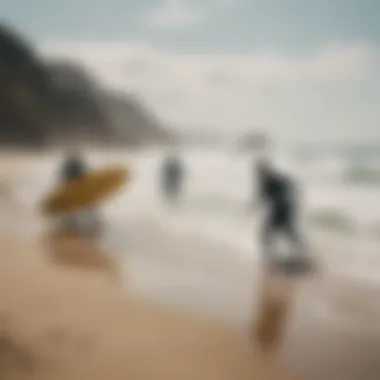

Understanding Terrain Hazards
Terrain hazards form the backdrop for many land surfing adventures and understanding these hazards is crucial for every rider. Uneven surfaces, steep inclines, and loose debris can quickly lead to disastrous falls. It’s akin to navigating a minefield while trying to balance on a board.
When considering hazards, it helps to be aware of one’s surroundings. Loose gravel or sand can cause the board to slide unpredictably, while steep driveways might pose a risk of both speed and sharp turns. Also, curbs and steps might seem harmless at first, but they can become major obstacles to an unaware rider.
Here are a few tips that can help in understanding and avoiding terrain hazards:
- Scout Your Route: Before surfing, take a walk through the area to identify problematic spots.
- Practice on Flat Surfaces: Mastering basic maneuvers on flatter, more controlled surfaces helps build confidence.
- Learn to Read the Ground: Being able to recognize changes in terrain enables quick adaptations, potentially preventing falls.
Keeping these considerations in mind will not only help in navigating the world of land surfing more safely but also elevate the overall riding experience.
Choosing the Right Land Surfboard
When it comes to land surfing, selecting the right land surfboard can make a world of difference. Whether you are a seasoned veteran or a fresh-faced enthusiast, understanding the nuances that come with your choice is crucial to enhancing your riding experience. Several factors weigh into this decision, more than just picking the flashiest design or the hottest new brand. Let's break down the key elements that should guide your selection process, which includes skill level and intended use.
Factors to Consider
Skill Level
One of the first things you should ponder is your skill level. It’s like trying to jump into a pool; if you don't know how deep it is, you might get in over your head. Beginner boards typically have a broader deck and larger wheels, making them more stable and easier to manage. This is beneficial because it lowers the chance of wiping out while you’re getting the hang of things.
More advanced riders, however, might gravitate toward boards that feature a narrower profile and smaller wheels. These boards are typically lighter and designed for high-speed maneuvers or tricks. The catch here is that they can be less forgiving on uneven surfaces.
In essence, understanding where you stand with your skills allows you to pick a board tailored for optimal enjoyment and challenge.
Intended Use
Now let's move onto intended use—it’s all about knowing where and how you plan to ride. If you're looking to carve through urban environments, a street board would be your best bet. These boards are designed for maneuverability and are often lighter, making them perfect for navigating tight corners and obstacles.
On the other hand, if you’re more into off-road trail rides, you'll want an all-terrain board. These have wider wheels and sturdier decks, suitable for handling rocks, dirt, and various obstacles without losing stability. With that said, they can feel a bit clumsy if you're trying to do tricks in a skate park.
Therefore, matching your board with your intended riding surface will significantly enhance your experience.
Top Brands in the Market
Finding the right board also involves considering top brands that have carved out a reputation in the market. Companies like LandSurf, Razor, and K2 tend to rise above the others. They are known for their quality craftsmanship and a variety of options catering to different skill levels and riding styles.
Each of these brands offers a unique flair, so it may be worth your while to test a few out in your local sporting goods store or at a riding event. You want a brand that resonates with you, not just in terms of quality, but also in style and the community surrounding it.
Ultimately, making an informed decision will contribute not just to your safety, but to your enjoyment as well.
Propelling Land Surfing into Other Disciplines
The fusion of land surfing with various other sports has gained significant traction in recent years. This integration not only amplifies the joy of riding but also helps in enhancing skills that are transferable across disciplines. Land surfing isn’t just an isolated activity; it merges seamlessly into a myriad of sports, benefiting both novice and seasoned riders.
Cross-Training Benefits
Cross-training through land surfing brings a variety of advantages. Riders can build balance, core strength, and endurance. For instance, mountain biking enthusiasts can incorporate land surfing sessions to develop lower body muscles and improve their overall balance on uneven surfaces. Think of it as a two-for-one workout; while you enjoy gliding on a land surfboard, you’re subtly boosting your biking skills without even realizing it.
- Muscle Development: Engages different muscle groups in the body. Riders not only work on their leg muscles but also their core, which is crucial for stability.
- Improved Agility: Regular practice leads to quicker reflexes, which is essential for sports like skateboarding and snowboarding. When navigating tricky terrains, every move counts.
- Stress Relief: As with any outdoor activity, land surfing concerns the mental aspect too. Riders often report a sense of calm and relaxation after a session, which can be beneficial for sports that demand high concentration.
The crux of cross-training is can be found in its ability to enhance overall performance. Riding is akin to peeling back layers of an onion; with each layer, new skills emerge, fortifying one’s ability to tackle different sports with confidence.
Integration with Other Water Sports
The charm of land surfing also lies in its affinity with water sports. While the ocean waves may be elusive on a land surfboard, the skills one gathers during land surfing can seamlessly translate to on-the-water experiences. From surfing to wakeboarding, each discipline strengthens foundational skills necessary for success.
For instance, an individual who excels at land surfing will find that their balance is better calibrated for traditional surfing. The same can be said for paddleboarding, where a sturdy stance becomes imperative for maneuvering through choppy waters. The relationship here is mutually beneficial, enhancing performance on both land and water.


Consider the following aspects of integration:
- Skill Transfer: Techniques learned in one sport can significantly improve performance in another. Paddling in water sports demands similar upper body strength and coordination as steering a land board.
- Community Expansion: Engaging in different riding experiences fosters community growth. Sharing insights from one platform to another creates a robust network of enthusiasts who are eager to learn from each other.
- Environmental Familiarity: Riders become attuned to various terrains, whether it’s a sandy beach or a grassy hilltop. This awareness translates into better navigation and adaptability in multiple environments.
"Riding across varied terrains nurtures a unique set of skills, connecting the passion for land and water sports."
Hence, embracing land surfing as a cross-disciplinary activity not only offers new challenges but also cements a deeper appreciation for all forms of riding. By combining practices from both land and water sports, riders broaden their horizons, turning each ride into a new adventure.
Environmental Considerations
As land surfing gains traction among outdoor enthusiasts, it's crucial to address the environmental considerations tied to this exhilarating sport. The interplay between the thrill of carving up various terrains and the preservation of those natural settings can often be a tightrope act. Understanding this dynamic not only enhances the experience but fosters a culture of responsibility among riders.
Impact on Natural Surfaces
Land surfboards, when used wisely, can offer an exhilarating experience on different terrains. However, improper use can lead to significant consequences for natural surfaces.
- Soil Erosion: Frequent riding on soft ground can cause soil compaction and erosion. These alterations can disrupt local ecosystems, making it a priority for riders to be conscious of their riding environments.
- Vegetation Damage: Riding in botanical-rich areas sometimes leads to trampling of fragile plants. It's important to stay on established pathways to avoid damaging vital plant life and promoting biodiversity.
- Wildlife Disruption: Noise and physical presence can disturb local wildlife. Awareness of seasons and breeding cycles can help minimize impact.
"Responsible land surfboarding is not just about the thrill; it's about protecting our playgrounds for future generations."
Sustainable Practices for Riders
To ensure that land surfing remains an enjoyable and sustainable activity, riders must adopt responsible practices. Here are some key actions that promote environmental stewardship:
- Know Your Terrain: Familiarize yourself with the areas you plan to ride. Look for locations where riding is encouraged and the impact on nature is minimized.
- Opt for Eco-Friendly Gear: Choose boards made from sustainable materials. Brands are increasingly producing surfboards with less harmful processes and eco-conscious raw materials.
- Limit Group Sizes: When hitting the trails, smaller groups lead to less environmental impact. More riders mean increased wear and tear on surfaces – so, make the adventure an intimate outing.
- Leave No Trace: Always pack out what you bring in. This includes trash, food, and any personal items.
Engaging in these sustainable practices paves the way toward ensuring the long-term viability of the sport. The mantra of protecting land while pursuing our passions should be deeply embedded in the land surfing culture.
Community and Culture
Land surfing is not just about the board or the thrill of riding; it's a vibrant culture that brings together a diverse array of individuals united by a common passion. From the way enthusiasts share tips, to the formation of local clubs and events, community plays a vital role in the world of land surfing. Understanding this community aspect can enrich the experience for anyone involved, whether new or seasoned rider.
Joining Local Groups and Events
Engaging with local groups and events is one of the easiest ways to immerse oneself in the land surfing lifestyle. These gatherings foster camaraderie, enabling riders to both learn from each other and share their unique experiences. Whether it's through community meetups or organized competitions, each event has its charm.
- Skill Development: Attending group rides or workshops can significantly enhance riding skills. No one teaches you better than someone who has been riding for years, sharing tricks or techniques that aren’t easily found in manuals.
- Friendship and Networking: Meeting fellow riders helps broaden your perspective. It’s often through these interactions that lifelong friendships form, creating a network that can transcend land surfing into other areas of life.
- Local Knowledge: Riding with others who are familiar with local terrain means you’ll learn about the best spots sooner and safer.
- Support and Encouragement: Being a part of a group can provide a motivational push. With shared enthusiasm, it’s easier to push personal boundaries and try advanced tricks without the fear of anonymous judgment.
Examples of groups: Many cities have dedicated land surfing clubs where members organize regular meetups. For instance, the Boston Land Surfing Crew not only hosts riding events but also participates in community service projects to give back.
Influence of Social Media
In the age of digital connectivity, social media acts as the lifeblood of the land surfing community. Platforms like Instagram and Facebook allow enthusiasts to showcase their skills, connect with others across the globe, and keep up to date with the latest trends.
- Sharing Expertise: When riders post videos and tutorials, they provide learning resources for beginners that might otherwise be hard to come by. It’s not uncommon to find detailed how-tos on various tricks or maintenance tips in the comments section.
- Building Global Networks: Riders can make connections well beyond their local scene. This global community can foster international collaborations, meeting up with riders in places like Hawaii or California.
- Event Promotion: Social media serves as an excellent tool for promoting events. Whether it’s a big land surf competition or a casual weekend ride, platforms help spread the word quickly and efficiently.
- Cultural Exchange: By interacting with riders from different regions, one gets a glimpse into various land surfing styles and techniques. This exchange cultivates a rich tapestry of shared experiences, encouraging inclusivity.
"The world feels smaller when you connect with someone who shares the same stoke – it’s like discovering a long lost friend every time you hop on your board."
As land surfing continues to grow, the significance of community and culture cannot be discounted. Joining local groups and engaging through social media amplifies the joy of riding, highlighting the collective spirit that defines this fascinating sport.
Culmination
The realm of land surfboarding holds a unique place within the broader landscape of outdoor sports. As people increasingly seek diverse activities that simulate the thrill of traditional surfing, understanding this niche becomes essential not just for enthusiasts but also for instructors and coaches. The future of land surfboarding glistens with possibilities, and recognizing key elements related to this activity can enhance its acceptance and popularization.
The Future of Land Surfboarding
The trajectory of land surfboarding is set to evolve in countless ways. First off, innovation in design is likely to play a significant role. Manufacturers are already experimenting with materials that minimize weight while maximizing durability. New wheel designs could improve maneuverability and grip, making boards more versatile for various terrains.
"Riders will want equipment that not only performs well on the pavement but can also adapt to rougher ground, enhancing their overall experience."
Moreover, as more people engage in outdoor activities during the pandemic, the community aspect is growing. Social media is emerging as a platform where surfers can showcase their skills. Forums such as Reddit contain threads filled with tips and tricks that further enrich knowledge in the sport. Local events are popping up, inviting newcomers and veterans alike to come together, share, and learn.
In terms of its integration with other sports, land surfboarding stands at a crossroads. The cross-training benefits with other disciplines like skateboarding, snowboarding, or even fitness regimes could define a new wave of enthusiasts. Promoting these synergies—where skills from one sport seamlessly translate into another—caters to an audience that's eager to enhance their athletic prowess.
The ecological impact of land surfboarding should also be in the conversation. With growing awareness around sustainability, there is a shift toward choosing eco-friendly materials and responsible riding practices. This change could draw environmentally conscious individuals into the fold, further expanding the community around land surfboarding.
As we look ahead, the potential for growth within land surfboarding represents not just an expansion of a sport but a movement that embodies a lifestyle. By remaining connected to nature, promoting safety, and fostering community, the future appears not only promising but also exhilarating for riders of all kinds.

